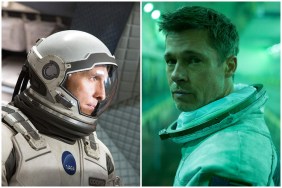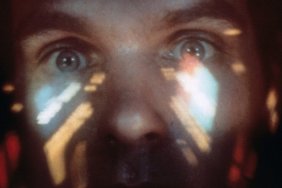When human beings make movies about bugs, we don’t expect bugs to actually watch them. If they did, real-life ants would probably see something like A Bug’s Life and have some serious reservations about it.
The same problem occurs when a fifth-dimensional being like Christopher Nolan tries to make a movie about simple human emotions instead of the complex philosophical and scientific concepts that he is clearly comfortable with. Nolan has made a cottage industry out of films in which men repress their emotions to get the job done, but in Interstellar he has directed a film about the opposite: emotions conquering cold, calculated logic. It’s an approach that might have worked just fine if he had found a way to express those emotions without the use of scientific formulas or cheap shot daddy issues.

Interstellar stars Matthew McConaughey as Cooper, a former astronaut who gave up on his dreams to provide for his family. The film takes place in the near future, when Earth’s resources are dwindling and society has taken to mass pragmatism, devaluing exploration and innovation in favor of an agricultural revolution in which everyone is either a farmer, or is encouraged to become a farmer.
A series of mysterious plot points leads Cooper right to the front door of NASA, now a top-secret organization investigating a mysterious wormhole that has opened up near the rings of Saturn. This wormhole is a gateway to another galaxy, where one of several planets might be capable of supporting human life and saving the species from extinction. Cooper’s mission is to pilot a spacecraft through this wormhole, where scientists Brand (Anne Hathaway), Doyle (Wes Bentley) and Romilly (David Gyasi) will determine which planet, if any, will be mankind’s salvation.

Interstellar is visually impeccable. It’s a glorious exploration of time and space featuring images of interstellar travel never before captured on camera. The film visualizes complex concepts involving gravity and the theory of relativity in one inspired moving image after another, crafting a nearly infinite scope that must be seen on the big screen, in 70mm, to be fully appreciated. There is one shot in which the vastness of space dwarfs a tiny celestial object; so tiny, in fact, that it would be difficult to spot on even some of the more ambitious TV screens. It is a massive “fuck you” to anyone who will ever try to watch Interstellar on an iPhone.
But the actual plot of Interstellar relies on enormous leaps in basic motivational logic that undermine all of the film’s technical accuracy. Before he can leave the planet, for example, Cooper must walk out on his crying daughter (Mackenzie Foy), who feels utterly abandoned. He refuses to tell her that the Earth is doomed because he wants her to feel safe. Then he entrusts her to the care of a scientist (Michael Caine), who promises to teach her exactly how doomed the world is.
If Christopher Nolan had merely glossed over this sort of plot kerfuffle – in same the way he glossed over all the myriad inconsistencies and plot contrivances in the Dark Knight trilogy – he might have got away with it. Instead, Interstellar uses this ill-conceived human drama to drive the rest of the plot forward. When people behave emotionally their decisions usually make little sense, and when they do make sense, it’s only because they have justified their actions through scientific theories that reduce the human soul to a math problem.

By the time Anne Hathaway describes love as the most powerful force in the universe – literally, right alongside the speed of light and gravity – it becomes abundantly clear that Christopher Nolan is viewing the more poetic aspects of the human experience in the abstract. It’s an approach that works perfectly well in an objective overview of mankind’s evolution, like 2001: A Space Odyssey, but it makes Interstellar’s many weepy moments and impassioned speeches seem rather hollow.
And by the fourth time Interstellar recites Dylan Thomas’s “Do not go gentle into that good night,” the poem has not only become meaningless, it has also exposed just how little meaning there really is to Interstellar. It shrinks love down to a callous theory while simultaneously trying to tug at humanity’s heart strings. It uses mind-bending scientific concepts to justify action sequences that dazzle, but are functionally just as ludicrous as anything you’d find in a Transformers movie. And it concludes in an absurd fashion that may be brilliantly visualized, but makes absolutely no sense for reasons I cannot describe without completely spoiling the plot of the movie.

Interstellar would be a stunning piece of cinema if you weren’t supposed to think about it, but Nolan’s problematic story challenges his audience with too many relevant social concepts, doomsday scenarios and impossible moral choices to prevent them from turning off their brains. And since your brains are already working, you might as well question all the gaps in rudimentary storytelling that derail this otherwise ambitious and beautifully produced popcorn movie, which only falls flat because it seems to be vying for the role of “best movie ever made.” Interstellar forces you to be too smart to enjoy Interstellar. I don’t think very many movies have had that problem before.
And yet… it should be seen. It should be viewed in a theater for the same reason that Speed Racer should be seen on your expensive home entertainment center: to show off just how good it looks. Look at how impressive the combination of images and sounds can be. Who cares if it doesn’t make as much sense as it thinks it does? Well, I care, and you should too, but as pure spectacle – and only as pure spectacle – Interstellar is admittedly one of the greats.

William Bibbiani is the editor of CraveOnline’s Film Channel and the host of The B-Movies Podcast and The Blue Movies Podcast. Follow him on Twitter at @WilliamBibbiani.





